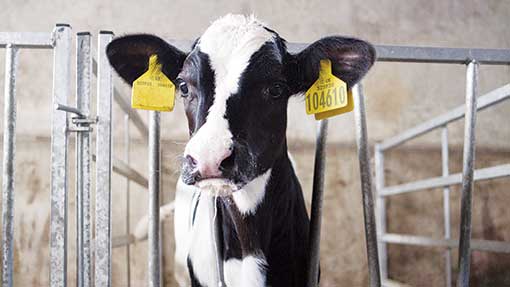The golden rules for calf housing

Moisture management, regulating fresh air and air speed, and being aware of the lower critical temperature requirement of the stock are golden rules of calf housing, according to DairyCo advisor Richard Davies.
He says a poor environment for youngstock is a contributory factor in the 25% heifer mortality rate, which occurs between birth and the start of second lactation.
Moisture control
Moisture control – both inside and outside the calf building – is critical to calf health.
“The problem with moisture is that cold water on concrete absorbs energy as it tries to evaporate. This evaporation takes energy from the calves that are housed so it’s essential to reduce the amount of water that’s slopping about inside a calf shed.
Water is also the perfect environment for many bacteria and viruses to thrive, so good drainage is essential inside the building to achieve a fall of 1 in 20.
That means for every 20 inches in length of the calf’s bed there needs to be a one inch fall to ensure any water or urine drains away quickly.
Outside the building the fall needs to be a minimum of one in 60 to achieve the same efficient system of moving water.
Mr Davies warned against washing down floors in calf houses. “It just adds even more moisture to the atmosphere. And outside it’s important to maintain gutters and drainpipes to make sure all water is taken away from the calf house as quickly as possible.
Tin roofs should also be avoided as they create too much condensation.
Ventilation
When it comes to fresh air it’s usually a case of too little being a problem rather than too much.
A shortage of fresh air in the calf house means pathogens will survive longer; even after allowing fresh air into a building for an hour, there can still be 70% of pathogens circulating in the atmosphere, so good and constant ventilation is essential.
Disease will persist in accommodation devoid of fresh air but it’s worth getting someone new to go into the calf building first thing in the morning and ask their opinion.
It’s very easy to get used to the smell of a building even though it may be obvious to a stranger that ventilation and fresh air issues need addressing.
It is important to measure the area of outlets that provide ventilation to the building. For a calf house there needs to be an allocation of 0.04sq/m per calf.
Roof height
Problems can occur in buildings with high roofs. When the roof of the building is high the air cools before it gets chance to rise high enough to allow it to leave the shed.
It then returns downwards arriving back on the stock. Where calves are housed in this type of building it’s important to ensure there’s adequate ventilation to allow for the height.
Draughts
Achieving adequate air speed in a calf building is vital to good stock health and testing the effectiveness of the ventilation can be easily undertaken using a smoke test – but equally there must be total control of draughts.
“Draughts are a killer and they must be eliminated. All gaps below doors must be covered,” says Mr Davies.
There is a huge difference in wind speed when you compare the speed of the air behind a door and the speed of the air coming underneath a gap of the same door.
It can be as much as 5m/second below the door and that’s equivalent to having calves standing in a stiff breeze.
And the speed of the air in a calf shed has a direct impact on the lower critical temperature. “Calves must be kept out of draughts because this will have a negative impact on the lower critical temperature.
If the lower critical temperature is below 9C calves will shiver and will need to eat more to help them keep warm. But ventilation must never be restricted in an attempt to raise the air temperature.
Air space allocation
A minimum air space of six cubic metres must be allocated for calves at birth and this should increase to 10 cubic metres by the time calves are eight weeks old and at least 10 cubic metres by the time they are six to seven months old.
Mr Davies says space allocation according to the size of calves can be easily calculated.
A calf weighing 45kg should be allocated 2sq/m and for calves from 46-99kg the allocation is 3sq/m.
For calves at three to five months old and weighing 100-149kg a space allocation of 4sq/m is recommended by DairyCo.
